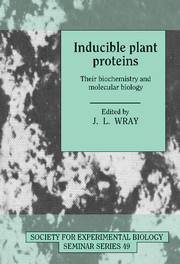Book contents
- Frontmatter
- Contents
- List of Contributors
- Preface
- Metal-binding proteins and metal-regulated gene expression in higher plants
- Phosphate starvation inducible enzymes and proteins in higher plants
- Nitrate reduction in higher plants: molecular approaches to function and regulation
- Inducibility of the glutamine synthetase gene family in Phaseolus vulgaris L.
- Expression and manipulation of genes involved in phenylpropanoid biosynthesis
- Biochemistry and molecular biology of CAM
- ABA- and GA-responsive gene expression
- Regulation of gene expression, ethylene synthesis and ripening in transgenic tomatoes
- Induction of nodulin genes and root nodule symbiosis
- Systemic acquired resistance: an inducible defence mechanism in plants
- Biochemistry and molecular biology of the anaerobic response
- The heat shock response in transgenic plants: the use of chimaeric heat shock genes
- Biochemistry and molecular biology of cold-inducible enzymes and proteins in higher plants
- GBF-1, GBF-2 and GBF-3: three Arabidopsis b-Zip proteins that interact with the light-regulated rbcS-1A promoter
- Index
Induction of nodulin genes and root nodule symbiosis
Published online by Cambridge University Press: 06 July 2010
- Frontmatter
- Contents
- List of Contributors
- Preface
- Metal-binding proteins and metal-regulated gene expression in higher plants
- Phosphate starvation inducible enzymes and proteins in higher plants
- Nitrate reduction in higher plants: molecular approaches to function and regulation
- Inducibility of the glutamine synthetase gene family in Phaseolus vulgaris L.
- Expression and manipulation of genes involved in phenylpropanoid biosynthesis
- Biochemistry and molecular biology of CAM
- ABA- and GA-responsive gene expression
- Regulation of gene expression, ethylene synthesis and ripening in transgenic tomatoes
- Induction of nodulin genes and root nodule symbiosis
- Systemic acquired resistance: an inducible defence mechanism in plants
- Biochemistry and molecular biology of the anaerobic response
- The heat shock response in transgenic plants: the use of chimaeric heat shock genes
- Biochemistry and molecular biology of cold-inducible enzymes and proteins in higher plants
- GBF-1, GBF-2 and GBF-3: three Arabidopsis b-Zip proteins that interact with the light-regulated rbcS-1A promoter
- Index
Summary
Introduction
Nitrogen is the most common limiting factor in the growth and productivity of plants. Legume plants, however, have overcome this limitation by developing the ability to harbour a group of soil bacteria (Azorhizobium, Bradyrhizobium, Rhizobium and Sinorhizobium spp.) in a symbiotic association. In this mutually beneficial interaction, bacteria invade the root cells of host plants where they become intracellular ‘organelles’ called bacteroids and are able to fix atmospheric dinitrogen into ammonium for assimilation by the plant. To facilitate this process, the host plant develops an entirely new organ, a root nodule, which houses the nitrogen-fixing bacteria and provides the carbon sources, other nutrients and appropriate environment to support the reduction of dinitrogen (see Verma & Long, 1983; Long, 1989; Verma & Stanley, 1989).
The Rhizobium–legume symbiosis, an interaction between a prokaryote (Rhizobium) and a eukaryote (legume), requires a series of sequential induction and function of both bacterium-encoded (bacteroidins) and host-encoded (nodulins) nodule-specific proteins. It has been shown that many plant (Peters et al., 1986; Firmin et al., 1986; Djordjevic et al., 1987; Sadowsky et al., 1988; see also Peters & Verma, 1990) and bacterial (Lerouge et al., 1990; Kondorosi, 1991) signals are involved in the induction of specific genes leading to the development of the root nodule. Many bacterial mutations blocking root hair deformation, induction of cortical cell division, infection thread formation and subsequent events leading to the endocytotic release of bacteria inside the host cell are known (see Rolfe & Shine, 1984).
- Type
- Chapter
- Information
- Inducible Plant ProteinsTheir Biochemistry and Molecular Biology, pp. 175 - 204Publisher: Cambridge University PressPrint publication year: 1992

